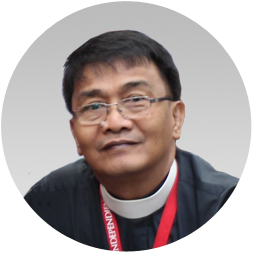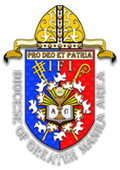Santo Niño Festival in the Philippines
A Reflection on the Celebration of the Feast of the Santo Niño
Paco IFI Parish of the Holy Sepulchre, January 24, 2021 (Sunday)

By: The Rev. Fr. Nixon Jose (Parish Priest)
The whole month of January is a celebration of the Feast of the Santo Nino (Child Jesus) in the different parts of the Philippines. This celebration is rooted in my home town in Kalibo, Aklan (Panay Island) where I originally came from. Many tourists from all over come to this event which the entire province lavishly spends money for its celebration. This is a religious church festival but it has become part of the city’s big annual event because of the economic benefits brought about by the celebration. Before, even starting in December, many locals, including the tourists, join the festivities on the streets; joyous, noisy, rowdy, and flamboyant.
The feast of the Santo Nino in Aklan became popular and it became called “Ati-atihan”. How did it start? There was a theory why this celebration became known as the “ati-atihan”. The natives, “ati” or the indigenous tribe (in other areas, called “mangyan”), were always under attack by the pirates from other neighboring islands. The “Aklanons” devised a plan to defend themselves and their locality from these assaults by making armaments like the bow-and-arrows, spears, and locally-made cannons. So, according to the story, even before the pirates could disembark from their boats to invade their territory, the Aklanons bombarded them with their cannons, and/or their spears and arrows to frighten or ward off the enemies. According to the ancient tradition, the cannons had to be cleaned before being fired; then filled with powder and ignited to thrust the cannon fire balls toward its target. It was necessary that the cleaning process and the installation of the cannon balls be rapidly done with the help of many persons. Due to these encounters and subsequent warding off of the enemies, the people involved in this defense process became dirty and black with ashes or soot. In this condition, they celebrated their triumph with joy and thanksgiving; looking more like the native black “Atis” in their physical appearance.
The second theory explained that the Atis’ conversion to Christianity was greeted as a joyous event. Since they did not have any loud instruments to proclaim their happiness, the Atis pounded two pieces of bamboo to create rhythmic noise as they paraded around the streets. Eventually, the drums in various sizes and musical tones came into use to replace the bamboos. The percussion rhythm of drums accompanied the wild chanting and dancing of the people as they carried the image of the Santo Nino along the parade route. The “Ati-atihan” festival of Aklan was copied by the other neighboring islands in the Visayas: the “Sinulog” in Cebu; the “Dinagyang” in Iloilo; the “Maskara” festival in Negros. These festivities were marked with the display of flamboyant colorful costumes, costume-dance contests, and parade floats. In Negros, unique in its celebration was the use of the “Maskara” or colorful masks and gaudy costumes, accompanied by noisy, wild merry-making. From these ostentatious celebrations, the Santo Nino festival was copied as well in the other parts of the country, and eventually reaching the urban cities of the Philippines including Metro Manila.
As we celebrate the Feast of the Holy Child, aside from the jubilant beatings of drums and colorful costumes of participants, first and foremost, we proclaim the greatest gift of God’s love to the world through the birth of His Son, our Lord and Savior Jesus Christ. According to the Gospel, the Word became flesh like one of us. He became a Child, like anyone of us; yet different from other children because He is holy. Why is this important? From the Scriptural readings – John 1:1-14, 18; 1 John 1: 5:20; Romans 9:5; Titus 2:13; 2 Peter 1:1 – these testify that Jesus is truly God who became human.
By celebrating the Feast of the Holy Infant/Child, we are proclaiming the bastion of our faith – the divine truth revealed to us by God, that from God’s love He gave Jesus to be born as a Child. This is the foundation of our faith that God is in Three Persons: Creator Father, Jesus the Son our Savior, and the Holy Spirit. In our spiritual connection to God, we recognize the divine and human natures of Jesus. In John’s advice to us (John 4:1-3), we must be wary of those who preach because they will insist that their doctrine is correct: either that Jesus is only human, prophet; or Jesus is only God, divine and not human. We shall be tested on our faith, but we can also test them on their beliefs.
Our Santo Nino festivity is a celebration of the divine revelation that our Lord Jesus is both God and human – born of the Blessed Virgin Mary through the Holy Spirit, died on the Cross and buried in the Holy Sepulcher, and rose from the dead to be reunited with God the Father. He taught us, by His becoming human, the truth, the way, and the fullness of life; and He will eventually come again to redeem us from our sins in order to be in fellowship with God in His Kingdom. May this truth give us meaning and purpose in celebrating the Feast of the Holy Child Jesus. In the Name of the Father, Son, and Holy Spirit.
Liturhiya para sa Kapistahan ng Banal na Sanggol
By: Rev. Fr. Nixon Jose


